Jade, Dragons, Snow and Mountains
The 'old town' of Lijiang is a tight labyrinth of narrow walkways separated by a series of meandering streams. During the day, the old town bustles with tourist traffic. Small shops sell minority clothing, jade jewelry and flutes, tea, and an assortment of other items. At night, all the red, hanging lanterns light up, giving the town a quaint, warm feel. The crowds real emerge after dark. The male and female employees of the local restaurants have nightly singing and chanting competitions. These impromptu street shows create a loud but inviting atmosphere for wandering or drinking hot-chocolate. And since none of the buildings are closed--their windows are always open during business hours--hot-chocolate can be quite inviting, along with the warm glow of the fireplaces.
 The 'iron-rainbow bridge' held a strategic placement during both the defense of China from the invading Japanese forces during World War II, but also for both the nationalist and communist troops during the struggle for power before and after WWII. This bridge crosses a tributary of the Yangtse river, and is situated on the outskirts of Shigu (pronounced 'sure goo'). Like many sites in China, this bridge cost money simply to take a picture of it. So I simply walked downstream to the modern concrete bridge and took my picture through the power lines. Shigu is situated in the mountains about an hour outside of Lijiang.
The 'iron-rainbow bridge' held a strategic placement during both the defense of China from the invading Japanese forces during World War II, but also for both the nationalist and communist troops during the struggle for power before and after WWII. This bridge crosses a tributary of the Yangtse river, and is situated on the outskirts of Shigu (pronounced 'sure goo'). Like many sites in China, this bridge cost money simply to take a picture of it. So I simply walked downstream to the modern concrete bridge and took my picture through the power lines. Shigu is situated in the mountains about an hour outside of Lijiang.
 While 'hanzi' or 'putonghua' are the official languages of greater China, the Naxi (Nah-she) people of Lijiang and the surrounding communities also speak a minority language: Dong Ba. Much more like hieroglyphics than the characters of putonghua, the Dong Ba language shows up on many signs and souvenirs. The sign below is printed in pinyin (the Enlgish version of Chinese), traditional Chinese characters, and Dong Ba pictures. With only a slight bit of imagination, one can see the similarity between the Chinese characters and the Dong Ba pictures.
While 'hanzi' or 'putonghua' are the official languages of greater China, the Naxi (Nah-she) people of Lijiang and the surrounding communities also speak a minority language: Dong Ba. Much more like hieroglyphics than the characters of putonghua, the Dong Ba language shows up on many signs and souvenirs. The sign below is printed in pinyin (the Enlgish version of Chinese), traditional Chinese characters, and Dong Ba pictures. With only a slight bit of imagination, one can see the similarity between the Chinese characters and the Dong Ba pictures.
 Hopefully you can read this short history of Lijiang. The town is approximately 800 years old and was, at one time, the principal city in Yunnan Province. As the sign says, the town is surrounded by mountains. While it is not unusual for Lijiang to receive snow, the general temperatures are only slightly cooler than Kunming, and the snow tends to be in the much higher surroundings of the rocky mountains encircling this small city.
Hopefully you can read this short history of Lijiang. The town is approximately 800 years old and was, at one time, the principal city in Yunnan Province. As the sign says, the town is surrounded by mountains. While it is not unusual for Lijiang to receive snow, the general temperatures are only slightly cooler than Kunming, and the snow tends to be in the much higher surroundings of the rocky mountains encircling this small city.
 What would a short excursion be without a picture of yours truly. In this picture, I am standing on the main street going into the old-town of Lijiang. On my right (the picture's left) the stream flows beneath that willow tree. As you may have seen in the first picture, the stream is stocked with goldfish and the occisional rainbow trout--I could not believe at first either, but when I got closer, I could see the obvious markings of that beautiful whitefish I am so used to from Montana. Over my left shoulder, in the distance, Jade Dragon Snow Mountain rises up
What would a short excursion be without a picture of yours truly. In this picture, I am standing on the main street going into the old-town of Lijiang. On my right (the picture's left) the stream flows beneath that willow tree. As you may have seen in the first picture, the stream is stocked with goldfish and the occisional rainbow trout--I could not believe at first either, but when I got closer, I could see the obvious markings of that beautiful whitefish I am so used to from Montana. Over my left shoulder, in the distance, Jade Dragon Snow Mountain rises up
over the city. An imposing mountain, the local governement used to allow skiing from the summit of the mountain's one cable car (chair lift). However, when we enquired about that possibility, a local travel agent informed us that this was no longer allowed. So I got to see Jade, Dragons, Snow and Mountains, but I still have not been able to go skiing. However, I keep hearing that there might be skiing in Zhong Dian, another three hours beyond Lijiang. Maybe next time.
 The 'iron-rainbow bridge' held a strategic placement during both the defense of China from the invading Japanese forces during World War II, but also for both the nationalist and communist troops during the struggle for power before and after WWII. This bridge crosses a tributary of the Yangtse river, and is situated on the outskirts of Shigu (pronounced 'sure goo'). Like many sites in China, this bridge cost money simply to take a picture of it. So I simply walked downstream to the modern concrete bridge and took my picture through the power lines. Shigu is situated in the mountains about an hour outside of Lijiang.
The 'iron-rainbow bridge' held a strategic placement during both the defense of China from the invading Japanese forces during World War II, but also for both the nationalist and communist troops during the struggle for power before and after WWII. This bridge crosses a tributary of the Yangtse river, and is situated on the outskirts of Shigu (pronounced 'sure goo'). Like many sites in China, this bridge cost money simply to take a picture of it. So I simply walked downstream to the modern concrete bridge and took my picture through the power lines. Shigu is situated in the mountains about an hour outside of Lijiang. While 'hanzi' or 'putonghua' are the official languages of greater China, the Naxi (Nah-she) people of Lijiang and the surrounding communities also speak a minority language: Dong Ba. Much more like hieroglyphics than the characters of putonghua, the Dong Ba language shows up on many signs and souvenirs. The sign below is printed in pinyin (the Enlgish version of Chinese), traditional Chinese characters, and Dong Ba pictures. With only a slight bit of imagination, one can see the similarity between the Chinese characters and the Dong Ba pictures.
While 'hanzi' or 'putonghua' are the official languages of greater China, the Naxi (Nah-she) people of Lijiang and the surrounding communities also speak a minority language: Dong Ba. Much more like hieroglyphics than the characters of putonghua, the Dong Ba language shows up on many signs and souvenirs. The sign below is printed in pinyin (the Enlgish version of Chinese), traditional Chinese characters, and Dong Ba pictures. With only a slight bit of imagination, one can see the similarity between the Chinese characters and the Dong Ba pictures. Hopefully you can read this short history of Lijiang. The town is approximately 800 years old and was, at one time, the principal city in Yunnan Province. As the sign says, the town is surrounded by mountains. While it is not unusual for Lijiang to receive snow, the general temperatures are only slightly cooler than Kunming, and the snow tends to be in the much higher surroundings of the rocky mountains encircling this small city.
Hopefully you can read this short history of Lijiang. The town is approximately 800 years old and was, at one time, the principal city in Yunnan Province. As the sign says, the town is surrounded by mountains. While it is not unusual for Lijiang to receive snow, the general temperatures are only slightly cooler than Kunming, and the snow tends to be in the much higher surroundings of the rocky mountains encircling this small city. What would a short excursion be without a picture of yours truly. In this picture, I am standing on the main street going into the old-town of Lijiang. On my right (the picture's left) the stream flows beneath that willow tree. As you may have seen in the first picture, the stream is stocked with goldfish and the occisional rainbow trout--I could not believe at first either, but when I got closer, I could see the obvious markings of that beautiful whitefish I am so used to from Montana. Over my left shoulder, in the distance, Jade Dragon Snow Mountain rises up
What would a short excursion be without a picture of yours truly. In this picture, I am standing on the main street going into the old-town of Lijiang. On my right (the picture's left) the stream flows beneath that willow tree. As you may have seen in the first picture, the stream is stocked with goldfish and the occisional rainbow trout--I could not believe at first either, but when I got closer, I could see the obvious markings of that beautiful whitefish I am so used to from Montana. Over my left shoulder, in the distance, Jade Dragon Snow Mountain rises upover the city. An imposing mountain, the local governement used to allow skiing from the summit of the mountain's one cable car (chair lift). However, when we enquired about that possibility, a local travel agent informed us that this was no longer allowed. So I got to see Jade, Dragons, Snow and Mountains, but I still have not been able to go skiing. However, I keep hearing that there might be skiing in Zhong Dian, another three hours beyond Lijiang. Maybe next time.

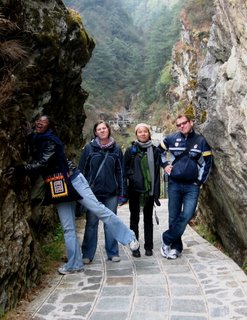 The trip began with an eight hour train ride. We actually missed our first train, so we took an overnight, sleeper train instead. We hopped on at about 21.00 and wound up in Dali at about 05.00 the next morning. A friendly cab driver dropped us off in front of a nice hotel, where we secured lodgings for 60kuai per head (less than $8 each). After three hours of sleep, we went out and downed some 'hundun' (like wonton soup), before hopping on our horses for the two-hour ride up the side of the mountains.
The trip began with an eight hour train ride. We actually missed our first train, so we took an overnight, sleeper train instead. We hopped on at about 21.00 and wound up in Dali at about 05.00 the next morning. A friendly cab driver dropped us off in front of a nice hotel, where we secured lodgings for 60kuai per head (less than $8 each). After three hours of sleep, we went out and downed some 'hundun' (like wonton soup), before hopping on our horses for the two-hour ride up the side of the mountains.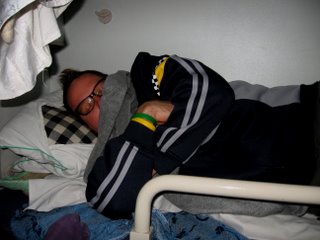
 This next picture is actually from earlier in the day. Suli had never ridden a horse until this moment. Being the smallest person in our group, she received the first horse that arrived. You can see Maya waiting for her horse. These pack animals looked like they could use some serious grooming. These horses are much smaller than the quarter-horses and show horses I am used to seeing in Montana. However, these little beasts sure could climb. We just had to hold on and remain calm. They did the rest. Across the four-lane highway that encircles Dali, you can see a section of restored wall. Down the hill from this wall is the old city. Beyond the old city is 'Er hai' (pronounced 'are high') lake. One can take boat tours of the this beautiful lake, but since I come from the land of Flathead Lake, I figured I could go out on a lake anytime. I wanted to go into the mountains.
This next picture is actually from earlier in the day. Suli had never ridden a horse until this moment. Being the smallest person in our group, she received the first horse that arrived. You can see Maya waiting for her horse. These pack animals looked like they could use some serious grooming. These horses are much smaller than the quarter-horses and show horses I am used to seeing in Montana. However, these little beasts sure could climb. We just had to hold on and remain calm. They did the rest. Across the four-lane highway that encircles Dali, you can see a section of restored wall. Down the hill from this wall is the old city. Beyond the old city is 'Er hai' (pronounced 'are high') lake. One can take boat tours of the this beautiful lake, but since I come from the land of Flathead Lake, I figured I could go out on a lake anytime. I wanted to go into the mountains. Here is a nice shot of one of the restored sections of the old wall. This wall was probably five yards wide. For 2 kuai, a person can walk along the restored wall. I actually saw a section of un-restored wall. I think I would not trust the un-restored section enough to walk on it. In the distance of this photo, beyond the smoke in the upper left, you may be able to see a tall pagoda rising above the city. This is not one of the famous White Pagodas. However, it is of a similar construction.
Here is a nice shot of one of the restored sections of the old wall. This wall was probably five yards wide. For 2 kuai, a person can walk along the restored wall. I actually saw a section of un-restored wall. I think I would not trust the un-restored section enough to walk on it. In the distance of this photo, beyond the smoke in the upper left, you may be able to see a tall pagoda rising above the city. This is not one of the famous White Pagodas. However, it is of a similar construction.
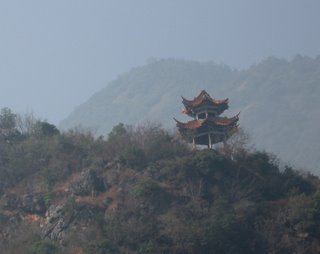
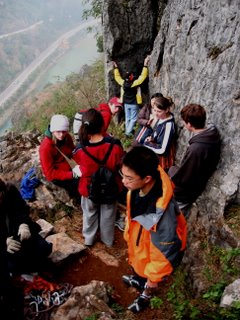
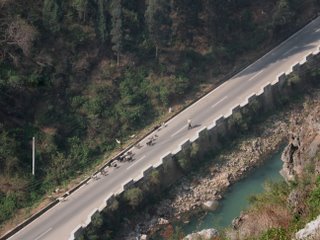
 This last photo shows Miss Carpenter setting the first route. As of right now, she will not be returning next school year. She has been here for six years, and may be moving to another school in South America. Her students love her, and the rest of the student body enjoys her adventure club--rockclimbing and mountain biking. I know I could never lead a rockclimbing club, but I hope to learn the mountainbiking trails in the Western Hills so that I can continue the riding side of the adventure club.
This last photo shows Miss Carpenter setting the first route. As of right now, she will not be returning next school year. She has been here for six years, and may be moving to another school in South America. Her students love her, and the rest of the student body enjoys her adventure club--rockclimbing and mountain biking. I know I could never lead a rockclimbing club, but I hope to learn the mountainbiking trails in the Western Hills so that I can continue the riding side of the adventure club.
 This next picture is the entry to Di Di's school. The words say, "Individuality of Teachers and Students is equal. Every Student Can Be Successful." In each classroom, a protrait of Chairman Mao hangs on one wall. Each room also has a poster depicting the proper way to do the daily facial exercises (massaging techniques). While there are other posters and pictures, the rooms are rather stark by Western standards. Like KIA classrooms, there is no heat, unless there is a wall mounted or free-standing floor heater. Generally, the classrooms are cold in the winter and hot in the summer. Actually, the concrete construction keeps the buildings relatively cool in the summer, but they never get warm in the winter. I guess it is a good thing that it does not snow too often--once every two to three years.
This next picture is the entry to Di Di's school. The words say, "Individuality of Teachers and Students is equal. Every Student Can Be Successful." In each classroom, a protrait of Chairman Mao hangs on one wall. Each room also has a poster depicting the proper way to do the daily facial exercises (massaging techniques). While there are other posters and pictures, the rooms are rather stark by Western standards. Like KIA classrooms, there is no heat, unless there is a wall mounted or free-standing floor heater. Generally, the classrooms are cold in the winter and hot in the summer. Actually, the concrete construction keeps the buildings relatively cool in the summer, but they never get warm in the winter. I guess it is a good thing that it does not snow too often--once every two to three years. This next shot was taken over Di Di's shoulder. As you can tell, the brush is held nearly vertical. In the first shot, the instructors brush does not appear to have the same vertical inclination, but I think that was only because he was standing and did not want to place his arm on the surface upon which he was working. At least three times, the teacher corrected me on my handling of my brush. You will see in a later photo how the wrist is cocked through the entire stroke. Generally, one uses the arm to, rather than the wrist, to write caligraphy. Di Di struggled during this lesson. With Michelle and my presence, he spent much of his time watching us and talking to his classmates about his Western visitors. All the students asked us our names. They were thrilled to use their English. Both Di Di's mother and the caligraphy instructor had to tell the other students to sit down and do their work. However, before they were sent to their desks, we met a young man (about nine years old) who had chosen Decimal as his English name. He was so cute in his pride over is name. We could hardly hold back our laughter.
This next shot was taken over Di Di's shoulder. As you can tell, the brush is held nearly vertical. In the first shot, the instructors brush does not appear to have the same vertical inclination, but I think that was only because he was standing and did not want to place his arm on the surface upon which he was working. At least three times, the teacher corrected me on my handling of my brush. You will see in a later photo how the wrist is cocked through the entire stroke. Generally, one uses the arm to, rather than the wrist, to write caligraphy. Di Di struggled during this lesson. With Michelle and my presence, he spent much of his time watching us and talking to his classmates about his Western visitors. All the students asked us our names. They were thrilled to use their English. Both Di Di's mother and the caligraphy instructor had to tell the other students to sit down and do their work. However, before they were sent to their desks, we met a young man (about nine years old) who had chosen Decimal as his English name. He was so cute in his pride over is name. We could hardly hold back our laughter. This last photo shows me struggling with my brush. Hopefully you view the photo the same way I do. There is an intentness to my work. However, my face is rather relaxed. Much like other forms of Zen meditation and relaxation, caligraphy finds its fluidity and beauty through relaxation, breathing and slow movements. While the instructor could obviously write faster than anyone else, his movements were still very deliberate and relaxed. When I slowed down and breathed, my puny efforts became magnified through more natural strokes. Therefore, caligraphy does not require the person performing the task to focus on the strokes; rather, it requires the person to focus on the breathing and the relaxation. As you can see in the photo, I am using a fill-in-the-space type primer. At first it appears easy, but believe me when I say that it is anything but simple. Michelle is in the background. My Di Di took the photo. I showed him how, and when he saw the actual picture he took, a huge smile crossed his face.
This last photo shows me struggling with my brush. Hopefully you view the photo the same way I do. There is an intentness to my work. However, my face is rather relaxed. Much like other forms of Zen meditation and relaxation, caligraphy finds its fluidity and beauty through relaxation, breathing and slow movements. While the instructor could obviously write faster than anyone else, his movements were still very deliberate and relaxed. When I slowed down and breathed, my puny efforts became magnified through more natural strokes. Therefore, caligraphy does not require the person performing the task to focus on the strokes; rather, it requires the person to focus on the breathing and the relaxation. As you can see in the photo, I am using a fill-in-the-space type primer. At first it appears easy, but believe me when I say that it is anything but simple. Michelle is in the background. My Di Di took the photo. I showed him how, and when he saw the actual picture he took, a huge smile crossed his face.

